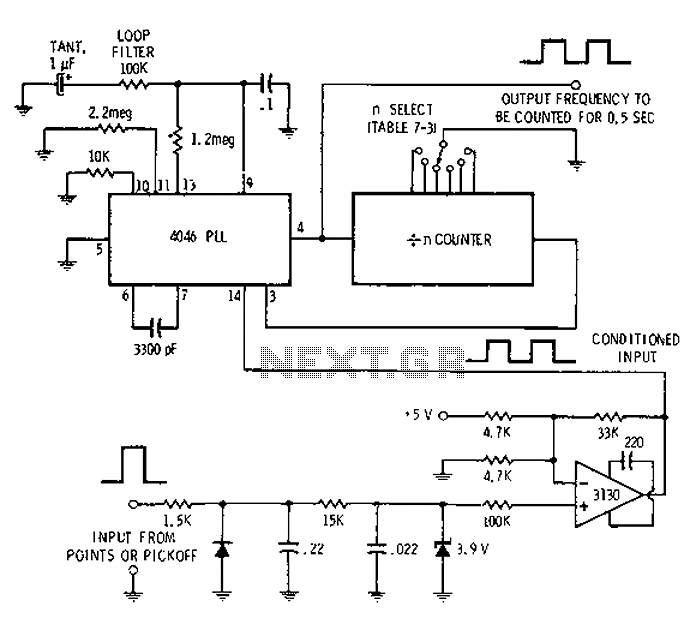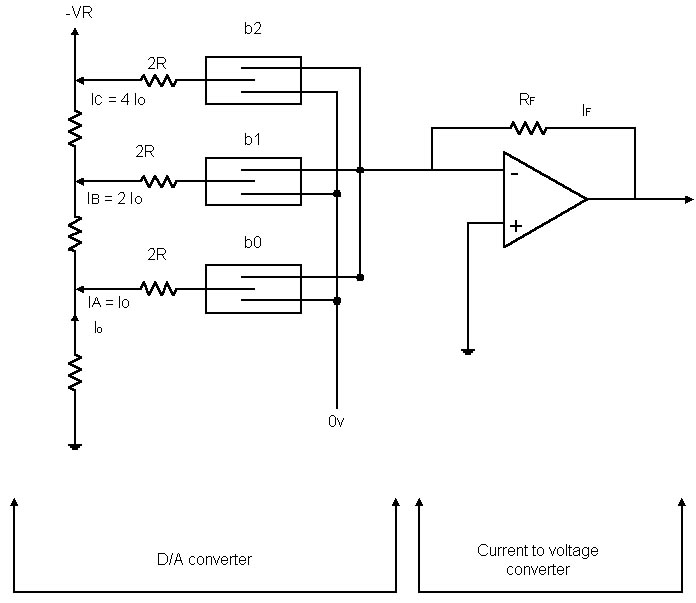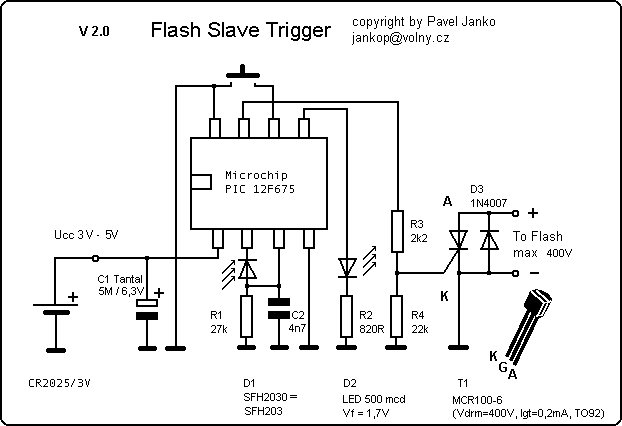
Digital tachometer schematic

Automotive engine pulse points or other sensors are filtered using the transmission device 3130 CMOS operational amplifier, which functions as a comparator to fulfill the input conditions. The pulse subsequently flows into a 4046 phase-locked loop (PLL) N-counter, which counts the number of engine cylinders (four-cylinder: 60, 6, 45, 8, 30 - a). The output frequency is set to 0.5 seconds to determine the engine speed in RPM.
The described circuit utilizes a 3130 CMOS operational amplifier configured as a comparator to filter automotive engine pulse signals. This configuration is essential for ensuring that the input signals are within the desired range for further processing. The operational amplifier's role is to compare the input pulse levels against a reference voltage, effectively filtering out noise and providing a clean signal for subsequent stages.
Following the filtering stage, the filtered pulse is directed to a 4046 phase-locked loop (PLL) N-counter. This component is crucial in applications where precise frequency counting is required, such as in automotive systems for monitoring engine performance. The N-counter counts the pulses generated by the engine, which corresponds to the number of cylinders in the engine. In this specific application, the counter is set to recognize a four-cylinder engine configuration, with specific pulse counts corresponding to different engine states (e.g., 60, 6, 45, 8, 30).
The output of the N-counter provides a frequency signal that is then used to calculate the engine speed in revolutions per minute (RPM). The design specifies an output frequency of 0.5 seconds, which allows for an accurate representation of the engine's operational state. This frequency measurement is critical for engine management systems, providing real-time data for performance tuning, diagnostics, and efficiency optimization.
Overall, the integration of the 3130 CMOS op-amp and the 4046 PLL N-counter within this circuit design exemplifies a robust approach to automotive engine monitoring, ensuring accurate pulse filtering and precise RPM measurement essential for modern engine control systems. Automotive engine pulse points or other sensors to be filtered in the transmission device 3130 CMOS op amp, the op amp is used as a comparator to complete the input conditions. Pulse then flows through to 4046 PLL-N counter, the counter counts the number of engine cylinders (four cylinder 60,6 45,8 30 - a) the output frequency is 0.5 seconds to get in rpm engine speed.
The described circuit utilizes a 3130 CMOS operational amplifier configured as a comparator to filter automotive engine pulse signals. This configuration is essential for ensuring that the input signals are within the desired range for further processing. The operational amplifier's role is to compare the input pulse levels against a reference voltage, effectively filtering out noise and providing a clean signal for subsequent stages.
Following the filtering stage, the filtered pulse is directed to a 4046 phase-locked loop (PLL) N-counter. This component is crucial in applications where precise frequency counting is required, such as in automotive systems for monitoring engine performance. The N-counter counts the pulses generated by the engine, which corresponds to the number of cylinders in the engine. In this specific application, the counter is set to recognize a four-cylinder engine configuration, with specific pulse counts corresponding to different engine states (e.g., 60, 6, 45, 8, 30).
The output of the N-counter provides a frequency signal that is then used to calculate the engine speed in revolutions per minute (RPM). The design specifies an output frequency of 0.5 seconds, which allows for an accurate representation of the engine's operational state. This frequency measurement is critical for engine management systems, providing real-time data for performance tuning, diagnostics, and efficiency optimization.
Overall, the integration of the 3130 CMOS op-amp and the 4046 PLL N-counter within this circuit design exemplifies a robust approach to automotive engine monitoring, ensuring accurate pulse filtering and precise RPM measurement essential for modern engine control systems. Automotive engine pulse points or other sensors to be filtered in the transmission device 3130 CMOS op amp, the op amp is used as a comparator to complete the input conditions. Pulse then flows through to 4046 PLL-N counter, the counter counts the number of engine cylinders (four cylinder 60,6 45,8 30 - a) the output frequency is 0.5 seconds to get in rpm engine speed.





